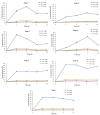Sweeteners' Influence on In Vitro α-Glucosidase Inhibitory Activity, Cytotoxicity, Stability and In Vivo Bioavailability of the Anthocyanins from Lingonberry Jams
- PMID: 37444306
- PMCID: PMC10340494
- DOI: 10.3390/foods12132569
Sweeteners' Influence on In Vitro α-Glucosidase Inhibitory Activity, Cytotoxicity, Stability and In Vivo Bioavailability of the Anthocyanins from Lingonberry Jams
Abstract
Several lines of evidence demonstrate the multiple health-promoting properties of anthocyanins, but little is known regarding the bioavailability of these phytochemicals. Therefore, the stability during storage and bioavailability of anthocyanins from lingonberries jams were determined by HPLC, together with the impact of used sweeteners on their adsorption. Further, the in vitro α-glucosidase inhibition using spectrophotometric methods and cytotoxicity determined on normal and colon cancer cells were communicated. The content of anthocyanins was significantly decreased during storage in coconut sugar-based jam, but was best preserved in jam with fructose and stevia. Fructose and stevia-based jams showed the highest inhibition activity upon α-glucosidase. Lingonberry jams showed no cytotoxic effects on normal cells, but at low concentration reduced the tumor cells viability. Anthocyanins were still detectable in rats' blood streams after 24 h, showing a prolonged bioavailability in rats. This study brings important results that will enable the development of functional food products.
Keywords: anthocyanins; bioavailability; cytotoxicity; lingonberry jams; sweeteners; α-glucosidase.
Conflict of interest statement
The authors declare no conflict of interest.
Figures





Similar articles
-
Estimation of degradation kinetics of bioactive compounds in several lingonberry jams as affected by different sweeteners and storage conditions.Food Chem X. 2022 Oct 12;16:100471. doi: 10.1016/j.fochx.2022.100471. eCollection 2022 Dec 30. Food Chem X. 2022. PMID: 36263245 Free PMC article.
-
Sweeteners from Different Lingonberry Jams Influence on Bioaccessibility of Vitamin C, Anthocyanins and Antioxidant Capacity under In Vitro Gastrointestinal Digestion.Antioxidants (Basel). 2022 Feb 23;11(3):442. doi: 10.3390/antiox11030442. Antioxidants (Basel). 2022. PMID: 35326093 Free PMC article.
-
Stability of Anthocyanins, Phenolics and Color of Tart Cherry Jams.Foods. 2019 Jul 12;8(7):255. doi: 10.3390/foods8070255. Foods. 2019. PMID: 31336964 Free PMC article.
-
Anthocyanins: Metabolic Digestion, Bioavailability, Therapeutic Effects, Current Pharmaceutical/Industrial Use, and Innovation Potential.Antioxidants (Basel). 2022 Dec 26;12(1):48. doi: 10.3390/antiox12010048. Antioxidants (Basel). 2022. PMID: 36670910 Free PMC article. Review.
-
Advances in embedding techniques of anthocyanins: Improving stability, bioactivity and bioavailability.Food Chem X. 2023 Nov 7;20:100983. doi: 10.1016/j.fochx.2023.100983. eCollection 2023 Dec 30. Food Chem X. 2023. PMID: 38144721 Free PMC article. Review.
References
-
- Han P., Yang P., Wang H., Fernandes I., Mateus N., Liu Y. Digestion and absorption of red grape and wine anthocyanins through the gastrointestinal tract. Trends Food Sci. Technol. 2019;83:211–224. doi: 10.1016/j.tifs.2018.11.025. - DOI
-
- Fernandes I., Faria A., Calhau C., de Freitas V., Mateus N. Bioavailability of anthocyanins and derivatives. J. Funct. Foods. 2014;7:54–66. doi: 10.1016/j.jff.2013.05.010. - DOI
-
- Cavalcante Braga A.R., Murador D.C., Mendes de Souza Mesquita L., de Rosso V.V. Bioavailability of anthocyanins: Gaps in knowledge, challenges and future research. J. Food Compos. Anal. 2018;68:31–40. doi: 10.1016/j.jfca.2017.07.031. - DOI
LinkOut - more resources
Full Text Sources

